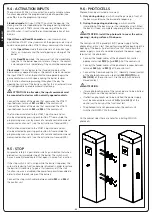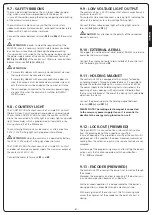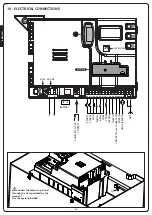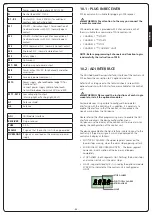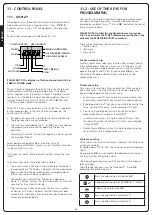
ENGLISH
- 35 -
1.1 - PRELIMINARY CHECKS AND IDENTIFICATION OF THE TYPE TO BE USED
The automation device should not be used until installation, as specified in “Testing and start-up”, has been performed.
It should be remembered that the device does not compensate for defects caused by improper installation, or poor maintenance, thus, prior
to proceeding with installation, ensure that the structure is suitable and meets current standards and, if necessary, perform any structural
modifications aimed at the implementation of safety gaps and the protection or segregation of all crushing, shearing and transit zones, and
verify that:
• The support on which the automation device will be fixed is solid and durable.
• The mains power supply to which the automation device is connected has a dedicated safety earthing system and differential breaker
with tripping current less than or equal to 30 mA (the breaker gap distance should be greater than or equal to 3 mm).
Warning: The minimum safety level depends on the type of use; please refer to the following outline:
GROUP 1
-
Only a limited number of people are authorised for use, and closure is not in a public area. Examples of this type are gates inside
business premises, where the sole users are employees, or a part of them who have been suitably informed.
GROUP 2
- Only a limited number of people are authorised for use, but in this case, closure is in a public area. An example of this may be a
company gate that accesses onto a public street, and which is only used by employees.
GROUP 3
- Anyone can use the automated closure, which is thus located on public land. For example the access gate to a supermarket or
an office, or a hospital.
PROTECTION A
- Closure is activated by means of a control button with the person present, i.e. with maintained action.
PROTECTION B
- With the person present, closure is activated by a command controlled by means of a key-switch or the like, in order to
prevent use by unauthorised persons.
PROTECTION C
- Restricts the force of the boom. I.e., in the case of the bomm striking an obstacle, the impact force must fall within a
curve established by the regulations.
PROTECTION D
- Devices, such as photocells, capable of detecting the presence of people or obstacles. They may be active on just one side
or on both sides of the boom.
PROTECTION E
- Sensitive devices, such as footboards or immaterial barriers, capable of detecting the presence of a person, and installed in
such a way that the latter cannot be struck in any way by a moving boom. These devices should be active within the entire “danger zone”
of the boom. The Machinery Directive defines “Danger Zone” as any zone surrounding and/or near machinery where the presence of an
exposed person constitutes a risk to the health and safety of that person.
The risk analysis should take into consideration all danger zones for the automation device, which should be appropriately
protected and marked.
In a clearly visible area, apply a sign with information identifying the motorised door or gate.
The installer should provide the user with all the information relating to automatic operation, emergency opening and
maintenance of the motorised door or gate.
CLOSURE USE TYPE
TYPE OF ACTIVATION
COMMANDS
GROUP 1
Informed people
(use in private area)
GROUP 2
Informed people
(use in public area)
GROUP 3
Informed people
(unlimited use)
Man-present command
A
B
Not possible
Remote control and closure in
view (e.g. infrared)
C or E
C or E
C and D or E
Remote control and closure not
in view (e.g. radio)
C or E
C and D or E
C and D or E
Automatic control
(e.g. timed closure control)
C and D or E
C and D or E
C and D or E
Summary of Contents for NIUBA-24V
Page 2: ...1153 mm 320 mm 287 mm 218 mm 897 mm 1168 mm 374 mm 239 mm 319 mm 897 mm ...
Page 7: ...ITALIANO 5 NIUBA4 NIUBA6 ...
Page 11: ...ITALIANO 9 FIG 3 FIG 4 ...
Page 13: ...ITALIANO 11 A D E C F F G E A B D C O N M ...
Page 31: ...ITALIANO 29 ...
Page 34: ...ITALIANO 32 ...
Page 39: ...ENGLISH 37 NIUBA4 NIUBA6 ...
Page 43: ...ENGLISH 41 FIG 3 FIG 4 ...
Page 45: ...ENGLISH 43 A D E C F F G E A B D C O N M ...
Page 63: ...ENGLISH 61 ...
Page 66: ...ENGLISH 64 ...
Page 71: ...FRANÇAIS 69 NIUBA4 NIUBA6 ...
Page 75: ...FRANÇAIS 73 FIG 3 FIG 4 ...
Page 77: ...FRANÇAIS 75 A D E C F F G E A B D C O N M ...
Page 95: ...FRANÇAIS 93 ...
Page 98: ...FRANÇAIS 96 ...
Page 103: ...ESPAÑOL 101 NIUBA4 NIUBA6 ...
Page 107: ...ESPAÑOL 105 FIG 3 FIG 4 ...
Page 109: ...ESPAÑOL 107 A D E C F F G E A B D C O N M ...
Page 127: ...ESPAÑOL 125 ...
Page 130: ...ESPAÑOL 128 ...
Page 131: ......


























